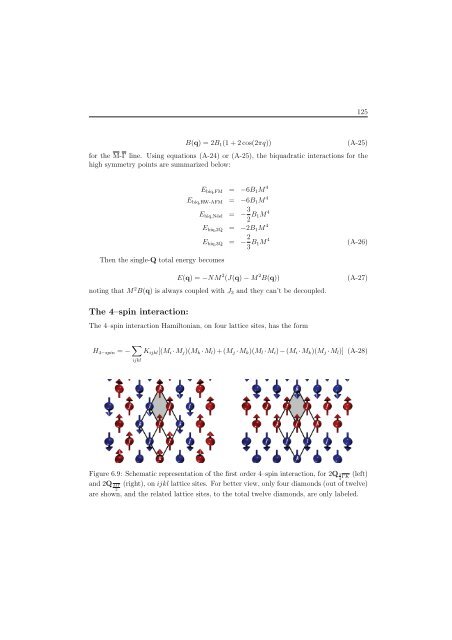Ab initio investigations of magnetic properties of ultrathin transition ...
Ab initio investigations of magnetic properties of ultrathin transition ...
Ab initio investigations of magnetic properties of ultrathin transition ...
Create successful ePaper yourself
Turn your PDF publications into a flip-book with our unique Google optimized e-Paper software.
B(q) =2B1(1 + 2 cos(2πq)) (A-25)<br />
for the M-Γ line. Using equations (A-24) or (A-25), the biquadratic interactions for the<br />
high symmetry points are summarized below:<br />
Ebiq,FM = −6B1M 4<br />
Ebiq,RW-AFM = −6B1M 4<br />
Ebiq,Néel = − 3 4<br />
B1M<br />
2<br />
Ebiq,2Q = −2B1M 4<br />
Ebiq,3Q = − 2<br />
Then the single-Q total energy becomes<br />
4<br />
B1M<br />
3<br />
125<br />
(A-26)<br />
E(q) =−NM 2 (J(q) − M 2 B(q)) (A-27)<br />
noting that M 2 B(q) is always coupled with J3 and they can’t be decoupled.<br />
The 4–spin interaction:<br />
The 4–spin interaction Hamiltonian, on four lattice sites, has the form<br />
H4−spin = − �<br />
Kijkl[(Mi ·Mj)(Mk ·Ml)+(Mj ·Mk)(Ml ·Mi)−(Mi ·Mk)(Mj ·Ml)] (A-28)<br />
ijkl<br />
Figure 6.9: Schematic representation <strong>of</strong> the first order 4–spin interaction, for 2Q 3<br />
ΓK (left)<br />
4<br />
and 2Q MΓ (right), on ijkl lattice sites. For better view, only four diamonds (out <strong>of</strong> twelve)<br />
2<br />
are shown, and the related lattice sites, to the total twelve diamonds, are only labeled.

















